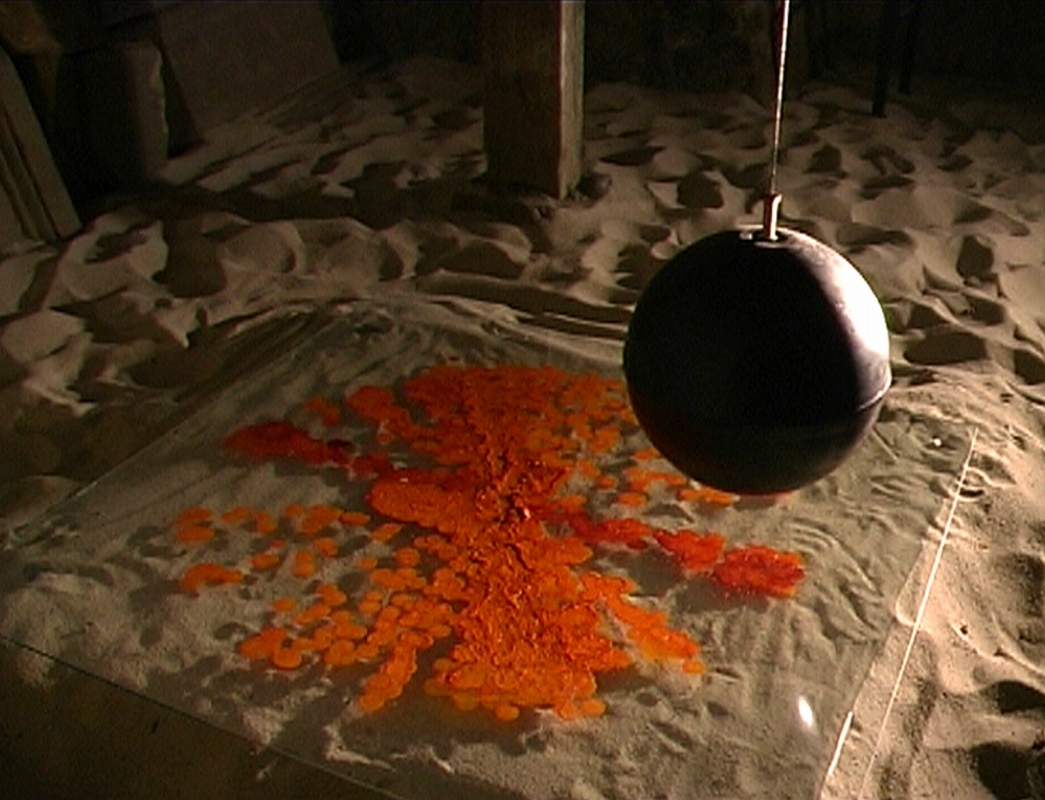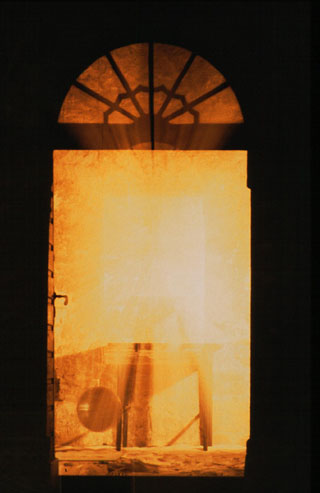
Time Puddles: An art installation on time
A sphere, little larger than a soccer ball, but heavier than a hundredweight due to its being filled with lead, is suspended by a long steel cable. The cable is attached at great height directly below the pinnacle of the church's steeple and extends with its ball to just above the floor. If the ball is in motion, then it swings back and forth slowly, almost infact so slowly as to be provoking, from one side to the other. If an observer spend several hours watching then he might suspect that someone was manipulating the pendulum at its point of attatchment under the church roof. The ball does not move back and forth but swings to and from the observer. Suddenly he realizes that the plane of the swinging pendulum has slowly rotated.
Since the day of Kopernicus and Galileo, man has known that the earth rotates. We forget this, however, when we view a wonderful sun "set", while in reality the sun is fixed and the earth turns in the sun's rays. And so the enigma of the pendulum is solved. The earth and with it the church and the observer himself turn underneath the freely swinging pendulum. And so primordal motion (earth's rotation) , driven since millions of jears by cosmic forces, and infinitesimal motion, initiated by a single human (pendulum's swing), are united in this installation. A picture of perfect regularity - a time pattern of both arises.
The sphere contains not only the lead's load, but also a paint container. A particular mechanism makes sure that at certain intervals colored paint drips from that container onto a plate of glass positioned only a few centimeters beneath the swinging lead sphere on the floor. If the falling droplets depict initially a linear configuration, then with continuing rotation of the plane of the pendulum's swing so the entire surface of the plate of glass will be covered. Chance enters the game in the form of a die. The temporal sequence with which the paint droplets fall is not regular. But rather the order of the droplets is determined anew each day by casting the die. It, therefore, can occur that following a "six" one drop falls only once every 85 minutes over the course of the next 24 hours. But next day, following a "one" numerous droplets flood the glass plate in a matter of minutes.


Could one imagine that the advance of the second hand were dependent upon the number of a die ? That the figures of the die constitute a time pattern as well, albeit a less accountable one, may appear strange at first sight. Nevertheless they can be projected on a time continuum, like hours, days and years. The difference is, that the time events do not follow one another by a distinct, continuous measure, but by a measure defined by chance, a somehow capricious measure. This time is not flowing regularly, but, instead, might be dawdling, first, to later hurry forward.
What would happen if two different times would be forced together , like the time of a an honest railway station clock and the time of someone fluctuating between mania and depression, sometimes exploding, sometimes, as if paralyzed, brought almost to a standstill ? Nothing new: it happens every day, only the pattern is not recognisable.
If such different time patterns are forced into coexistence, warps and fractures are unavoidable. Still, something new may arise, which would have had no chance under the dictatureship of ‘one-dimensional’ time. Fortunately, such ’one-dimensional’ time only exists in theory, in olympic ice rinks, and on the agenda of modern time-economy advisers.
The configuration finally "caught" on the glass plate owes its origin to the interplay of "Chance and Necessity" (Jacques Monod), the fall of the die and physic's eternal laws. Can one rely on nature? Certainly, one can rely on nature's immutable laws as long as nature continues to adhere to them. But chance raises havoc, and so much originated in the course of evolution which carries the label of natural law but in reality might have been entirely different, i.e. desoxyribonucleic acid (DNA) or the Rocky Mountains.




Longitude: 10° 25' 44'' East. Latitude: 51° 54' 24'' North. 446 mi east of Greenwich. 3574 mi north of the equator.
Technical support: Dr. rer. nat. H. Modler and Photos: Regina Nelle and Peter Kaubisch